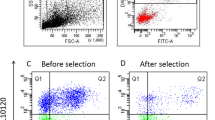Abstract
Sperm morphology has been suggested to be one of the most reliable factor in predicting male fertility potential both in spontaneous cycles and in assisted reproduction. In this work the morphology of spermatozoa selected with three different techniques (layering, swimup from pellet and mini-percoll) has been assessed and compared in 20 infertile patients. All the techniques allowed the recovery of sperm populations of a better quality than in basal samples, with a higher percentage of normal forms (p<0.001). No significant differences were observed among the three different techniques in selecting sperm populations. The scatter diagrams comparing pairwise differences between the methods against their means regard the percentage of normal forms selected show a great (over 20%) inter and intra-individual variability. These data demonstrate that the three techniques select different percentages of normal spermatozoa, even in the same patient. Since it is crucial to obtain the highest number of morphologically normal and motile spermatozoa and each technique may provide different results in a given patient, we suggest that at least two techniques of sperm selection be performed before assisted reproduction procedures. This combined testing could also be relevant in the prognostic evaluation of the infertile male, since it explores the different characteristics of sperm function.
Similar content being viewed by others
References
Bostofte E., Serup J., Rebbe H. Relation between morphologically abnormal spermatozoa and pregnancies obtained during a twenty-year follow-up period. Int. J. Androl. 5: 379, 1982.
Mahadevan M.M., Trounson A.O. The influence of seminal characteristics on the success rate of human in vitro fertilization. Fertil. Steril. 42: 400, 1984.
Kobayashi T., Jinno M., Sugimura K., Nozawa S., Sugiyama T., Lida E. Sperm morphological assessment based on strict criteria and in-vitro outcome. Hum. Reprod. 6: 983, 1991.
Liu D.Y., Baker H.W.G. Tests of human sperm function and fertilization in vitro. Fertil. Steril. 58: 465, 1992.
Soffer Y., Golan A., Herman A., Pansky M., Caspi E., Ron-El R. Prediction of in-vitro fertilization outcome by sperm penetration assay with TEST-yolk buffer preincubation. Fertil. Steril. 58: 556, 1992.
Punjabi U., Gerris J., vanBijlen J., Delbeke L., Gielis M., Buytaert P.H. Comparison between different pre-treatment techniques for sperm recovery prior to intrauterine insemination, GIFT or IVF. Hum. Reprod. 5: 75, 1990.
Lopata A., Patullo M.J, Chang A., James B. A method for collecting motile spermatozoa from human semen. Fertil. Steril. 27: 677, 1976.
Aitken R.J., Clarkson J.S. Significance of reactive oxygen species in defining the efficacy of sperm preparation techniques. J. Androl. 9: 367, 1988.
Mortimer D. Sperm preparation techniques and iatrogenic failures of in-vitro fertilization. Hum. Reprod. 6: 173, 1991.
Berger T., Marrs R.P., Moyer D.L. Comparison of techniques for selection of motile spermatozoa. Fertil. Steril. 43: 268, 1985.
Ord T., Patrizio P., Marello E., Balmaceda J.P., Asch R.H. Mini-Percoll: a new method of semen preparation for IVF in severe male factor infertility. Hum. Reprod. 5: 987, 1990.
Davis R.O., Bain D.E., Siemers R.J., Thal D.M., Andrew J.B., Gravance C.G. Accuracy and precision of the CellForm-Human automated sperm morphometry instrument. Fertil. Steril. 58: 826, 1992.
WHO Laboratory Manual for the examination of human semen and sperm-cervical mucus interaction. Cambridge University Press, 1992.
Schoenfeld C., Amelar R.D., Dubin L., Amelar S. A new staining technique for the rapid determination of the morphologic characteristics of sperm. Fertil. Steril. 36: 408, 1991.
Bland J.M., Altman D.G. Statistical methods for assessing agreement between two methods of clinical measurement. Lancet 1: 307, 1986.
VanDerZwalmen P., Bertin-Segal G., Geerts L., Debauche C., Schoysman R. Sperm morphology and IVF pregnancy rate: comparison between Percoll gradient centrifugation and swim-up procedures. Hum. Reprod. 6: 581, 1991.
Ng F.L.H., Liu D.Y., Baker H.W.G. Comparison of Percoll, mini-Percoll and swim-up methods for sperm preparation from abnormal semen samples. Hum. Reprod. 7: 261, 1992.
Schwartz D., Ducot B., Auroux M., Collin C. Within-subject variability of the percentage of mophologically abnormal spermatozoa among infertile men: biological and measurement components. Hum. Reprod. 1: 369, 1986.
Author information
Authors and Affiliations
Rights and permissions
About this article
Cite this article
Canale, D., Giorgi, P.M., Gasperini, M. et al. Inter and intra-individual variability of sperm morphology after selection with three different techniques: Layering, swimup from pellet and percoll. J Endocrinol Invest 17, 729–732 (1994). https://doi.org/10.1007/BF03347769
Received:
Accepted:
Published:
Issue Date:
DOI: https://doi.org/10.1007/BF03347769




